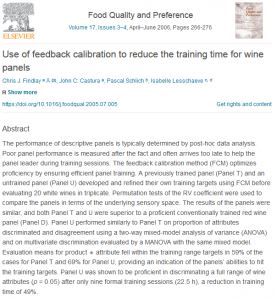Use of feedback calibration to reduce the training time for wine panels
 The performance of descriptive panels is typically determined by post-hoc data analysis. Poor panel performance is measured after the fact and often arrives too late to help the panel leader during training sessions. The feedback calibration method (FCM) optimizes proficiency by ensuring efficient panel training. A previously trained panel (Panel T) and an untrained panel (Panel U) developed and refined their own training targets using FCM before evaluating 20 white wines in triplicate. Permutation tests of the RV coefficient were used to compare the panels in terms of the underlying sensory space. The results of the panels were similar, and both Panel T and U were superior to a proficient conventionally trained red wine panel (Panel D). Panel U performed similarly to Panel T on proportion of attributes discriminated and disagreement using a two-way mixed-model analysis of variance (ANOVA) and on multivariate discrimination evaluated by a MANOVA with the same mixed model. Evaluation means for product ∗ attribute fell within the training range targets in 59% of the cases for Panel T and 69% for Panel U, providing an indication of the panels’ abilities to hit the training targets. Panel U was shown to be proficient in discriminating a full range of wine attributes (p = 0.05) after only nine formal training sessions (22.5 h), a reduction in training time of 49%.
The performance of descriptive panels is typically determined by post-hoc data analysis. Poor panel performance is measured after the fact and often arrives too late to help the panel leader during training sessions. The feedback calibration method (FCM) optimizes proficiency by ensuring efficient panel training. A previously trained panel (Panel T) and an untrained panel (Panel U) developed and refined their own training targets using FCM before evaluating 20 white wines in triplicate. Permutation tests of the RV coefficient were used to compare the panels in terms of the underlying sensory space. The results of the panels were similar, and both Panel T and U were superior to a proficient conventionally trained red wine panel (Panel D). Panel U performed similarly to Panel T on proportion of attributes discriminated and disagreement using a two-way mixed-model analysis of variance (ANOVA) and on multivariate discrimination evaluated by a MANOVA with the same mixed model. Evaluation means for product ∗ attribute fell within the training range targets in 59% of the cases for Panel T and 69% for Panel U, providing an indication of the panels’ abilities to hit the training targets. Panel U was shown to be proficient in discriminating a full range of wine attributes (p = 0.05) after only nine formal training sessions (22.5 h), a reduction in training time of 49%.
![]()
Findlay, C. J., Castura, J. C., Schlich, P., & Lesschaeve, I. (2006). Use of feedback calibration to reduce the training time for wine panels. Food Quality and Preference, 17, 266-276. http://dx.doi.org/10.1016/j.foodqual.2005.07.005